Knitted with One thread
| May 30, 2023What’s drawing national-religious youth to the most insular chassidic courts
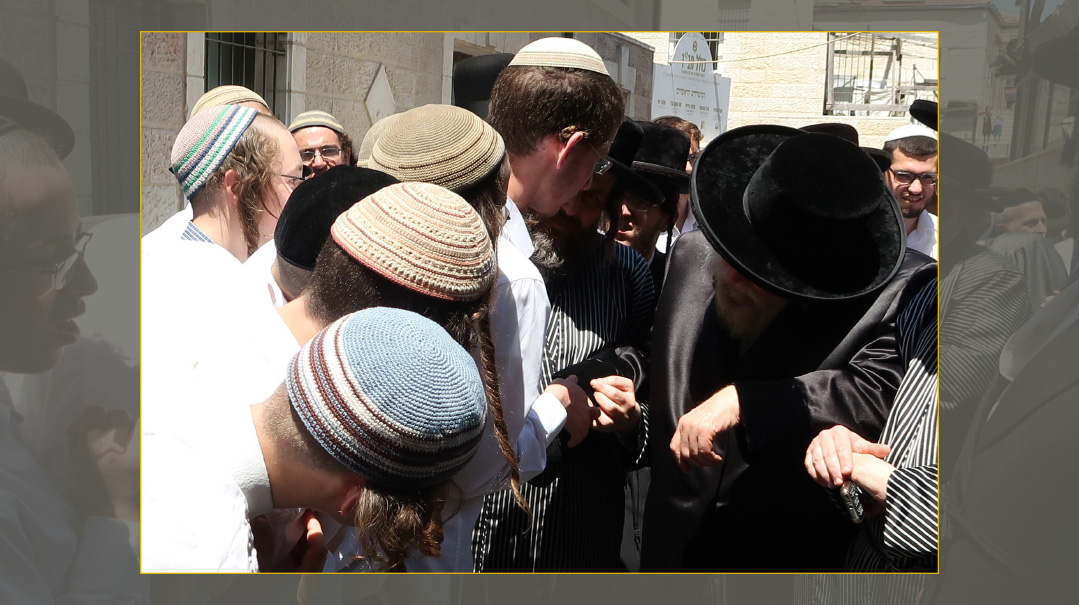
Photos: Shuki Lehrer, Flash90, Refoel Schwartz
Rachel Ginsberg contributed to this report.
They’re easy to spot at Friday night tishen in chassidic courts, with their white shirts, ear-to-ear huge knitted kippot, long peyos and untrimmed beards. Yet for some of these national-religious bochurim, a chassidic tish is not just another cool Shabbos activity, but a sign of retaking stock and making profound, meaningful life changes. And surprisingly, some of them are ideologically not so far away from their chassidic hosts either
You can see them at almost every tish of Jerusalem’s many chassidic courts. They’re usually off in their own corner, but easy to spot amid the beketshes and shtreimels: white shirts sashed with a gartel, long peyos, untrimmed beards, heads topped with large knitted yarmulkes that go from ear to ear.
Welcome to the phenomenon of young “srugim” (as they are called because of their kippot serugot) who have become regulars among the chassidim — bochurim and avreichim affiliated with “kippah serugah” yeshivos, well-versed in chassidic seforim and filled with lofty aspirations, who’ve forged personal bonds with rebbes and chassidic mashpi’im, and merit a special status even within the most insular chassidic groups.
Perhaps the most visible leader of this trend is the Toldos Avraham Yitzchak Rebbe, Rav Shmuel Yaakov Kohn, who has become a personal mashpia to many of these spiritual seekers. The chassidus was established in 1996 as an offshoot of Toldos Aharon after the previous Toldos Aharon Rebbe, Rav Avraham Yitzchak Kohn, passed away. His oldest son, Rav Shmuel Yaakov — a talmid of Vizhnitz — became the Toldos Avraham Yitzchak Rebbe, while his son Rav Dovid was called back from his Monsey kehillah to lead the Toldos Aharon chassidus. The two brothers hold court a block apart from each other.
Some bochurim — like Yonatan Lieber of the Mercaz Harav yeshivah — have forged such close personal ties with Toldos Avraham Yitzchak that any personal simchah without the Rebbe wouldn’t be complete. That’s why, when Yonatan got married last year, he chose to make the chuppah outside the Toldos Avraham Yitzchak beis medrash, just like the other bochurim of the chassidus do. With the permission of his rosh yeshivah, Rav Yaakov Shapira, the chassan asked the Rebbe to be his mesader kiddushin, and the very un-chassidish-looking wedding party stood under the chuppah on Rechov Oneg Shabbos across the road from the Meah Shearim shuk.
Afterward, chassidim stood alongside friends from Mercaz Harav as the chassan danced in another kind of mitzvah tantz, an embrace with both the Rebbe and Rav Yaakov Shapira.
(For Rav Shapira, who spent all his yeshivah years in Mercas Harav as son of the previous rosh yeshivah, it wasn’t really foreign territory. “What did we do on Friday night?” he once told his students. “We went to the tish of the Beis Yisrael of Gur, then on to the Biala Rebbe’s tish, and before that, we would go listen to the shmuess of Rav Ovadiah in the dining room of Yeshivat Porat Yosef.”)
“During the dance, people had tears in their eyes,” says Chagai Suissa, a fellow Mercaz Harav talmid and a close friend of the chassan.
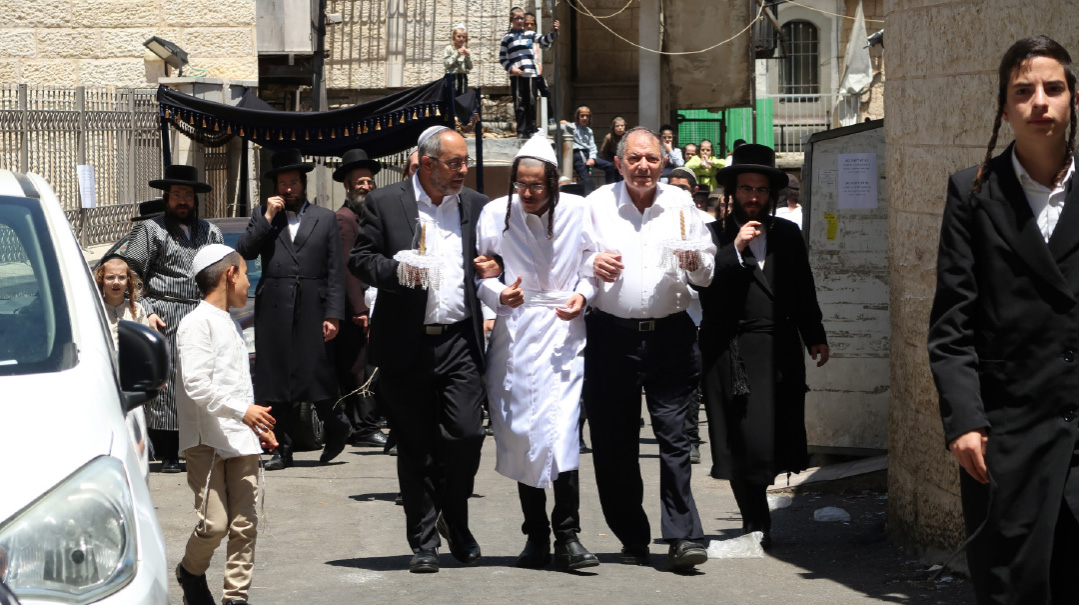
With such close ties to Toldos Avraham Yitzchak, how could this Mercaz Harav chassan have his chuppah anywhere else?
Chagai, who is Sephardi and grew up in the national religious sector, is also a regular on the chassidic tish circuit, especially in the court of Toldos Avraham Yitzchak. “It’s true that the lifestyle, the cultural nuances, are pretty different from ours, as is the nusach of the tefillah. And of course, where would I have picked up Yiddish? But I’m open to anything that brings us closer to a more intense avodat Hashem, to a real and personal relationship with HaKadosh Baruch Hu — I don’t want to serve Him with a hollow heart,” he says.
Chagai admits that before his personal foray into Meah Shearim, the extent of his personal knowledge about the chareidi and chassidic worlds was very limited — and it all came from the skewed lens of the media. Until some friends invited him to come along to a Toldos Avraham Yitzchak tish.
“At first it was a little off-putting,” he remembers. “I watched as a whole army of identically-dressed chassidim stood on the bleachers, singing in unison and gazing at the Rebbe as if he were their king. But then something unexpected happened — I found that the niggunim and songs had somehow opened up a deep place in my soul. I felt a strong tug to go back there.”
Suissa began to pick up the pace, soon attending the tishen every Friday night. “I felt myself rising to higher spheres in avodas Hashem, and it was always a letdown when it came to an end. I was usually so electrified that I would go from there to the Kotel. I couldn’t just go back to yeshivah to sleep.”
Suissa says that his sector is drawn to Toldos Avraham Yitzchak because of the warmth, the fire, the spiritual energy, and the surprising personal attention to this sector from the Rebbe himself. But maybe it’s not so surprising after all.
Although the Rebbe is already 80, has difficulty getting around, and his chassidim are culturally on a different page (they dress in the “zebra” caftans, lead very insular lives, and speak Yiddish), the chassidus is very warm and very open to guests, welcoming all those who are interested in forging a relationship. And much of that has to do with the Rebbe himself.
His father, the previous Toldos Aharon Rebbe, sent him to learn under the Imrei Chaim of Vizhnitz, with whom Rav Shmuel Yaakov maintained a close rebbe-chassid relationship until the Imrei Chaim’s passing in 1972, even though the Imrei Chaim’s approach to avodah, as well as to the State of Israel, differed considerably from that of Rav Shmuel Yaakov’s father. While Toldos Aharon was known for its strictures and devout practices and its fervent anti-Zionist and anti-Agudah position, Rav Shmuel Yaakov, who always considered himself a Vizhnitzer chassid, somehow maintained a balance between his father’s approach and that of the Imrei Chaim, who was a leader of Agudas Yisrael in Israel and the spiritual mentor of the Agudah party in the Knesset.
Yet for all the graciousness of their hosts, Suissa and his friends prefer to remain in their separate corner.
“The truth is that all us srugim stay together,” he says. “We stand on the bleachers in a spot where we have a good view, and every week without fail, the Rebbe fills a large plate with shirayim and signals for us to take it. The Rebbe even has a name for us – ‘di vayse bochurim’ — because of our white shirts.”
Suissa, always looking for new avenues of inspiration, hasn’t sufficed with Toldos Avraham Yitzchak alone. “The Tolna Rebbe holds a tish on Shabbos Mevarchim, and it’s always filled with us dati-leumi fellows,” he says. “After the tish ends, there are chassidic niggunim, some talks in Yiddish, and then dancing around the table. One time, the Tolna Rebbe motioned for all those wearing a kippah serugah to come up to his house.
“The Rebbe always takes an interest in us — ‘Where are you from?’ ‘Where do you learn?’ ‘Do you have questions in avodas Hashem?’ He once told us that the forty dapim of Gemara he remembers best are those that he studied for his matriculation exams when he learned in Netiv Meir yeshivah high school before moving on to Tchebin.” (The Rebbe is the grandson of the previous Rebbe through his mother. His father, Rav Tzvi Weinberg, was a scholar and lover of Eretz Yisrael who bridged many worlds and had several positions, including running the Ministry of Religion.)
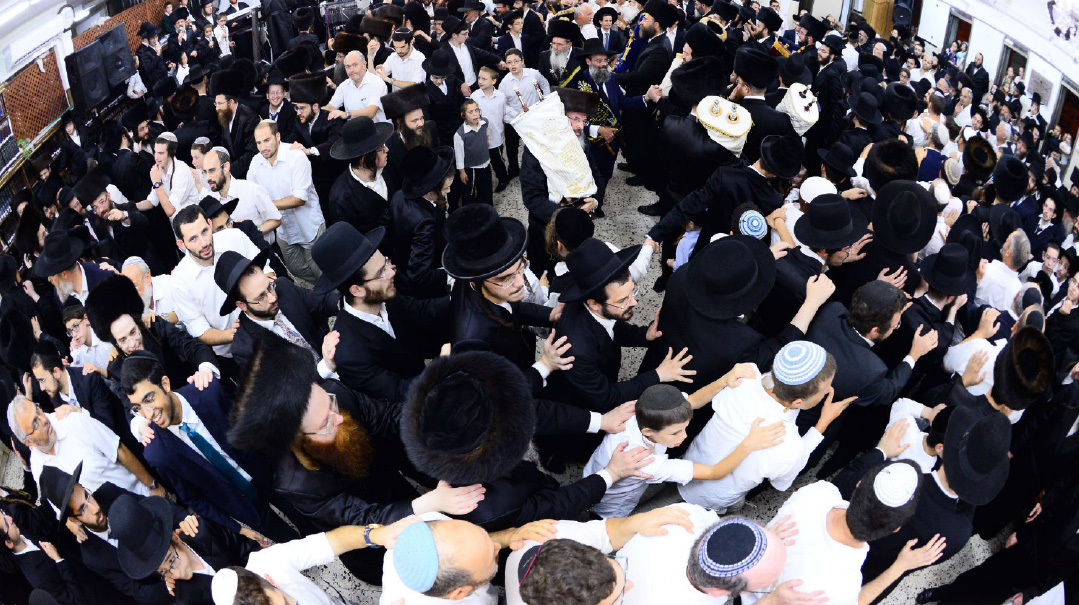
More Simchah
Not all the yeshivos in the National Religious sector are pleased with this growing trend. In some high schools, the roshei yeshivah have forbidden teenage bochurim from attending tishen for a number of reasons: Either the schools are Litvish in orientation, they don’t want prolonged absences from the yeshivah, or they’re concerned about disciplinary issues, off-campus unsupervised absences, or other violations of the rules.
But there is a trend among other mesivtos and yeshivah high schools to encourage a connection with the chassidic world and the infusion of spiritual energy it engenders. One example of this new shift is the Nachlat Yisrael yeshivah in Migdal Ha’emek, part of a network of Torani-leumi yeshivos and kollelim with a strong chassidic bent (the name, Nachlat Yisrael is after the Baal Shem Tov), established in 2003 by Rabbi Shneur Ketz. Rabbi Ketz is known for introducing his teenage talmidim — who come from all over the country —not only to the internal spiritual work of chassidus, but also to the very physical experience of a chassidish tish.
The Nachlat Yisrael phenomenon isn’t relegated to this northern town either: Yeshivah Ketanah Shalom Bonayich in Jerusalem’s Kiryat Yovel neighborhood, for example, is also known as a “hotbed” of chassidus, many of its students affiliating with the various chassidic courts in the Holy City.
For some of these students, a chassidic tish is not just some cool activity or new way to enjoy Shabbos; it’s more about retaking stock of life and making profound, meaningful changes.
That’s what happened to Yair, a 20-something father of three who followed two of his brothers to Toldos Avraham Yitzchak while still a bochur. While he says he has no intention of changing his dress or his lifestyle — he learns in a Mercaz Harav-affiliated kollel and lives on a hilltop between Jerusalem and Beit El with half a dozen other families — he and his family have adopted some specifically chassidic practices: Yair wears a gartel for davening and during Shabbos seudos; he and his wife are strict about washing for Melaveh Malkah with a full fleishig meal; the family now keeps the later Rabbeinu Tam zeman for Havdalah; Yair spends the major Yamim Tovim with the chassidus, and they even have a picture of the Toldos Avraham Yitzchak Rebbe hanging in their hilltop living room.
“He’s our rebbe in ruchniyus,” says Dalia, Yair’s wife. “Still, when it comes to halachic day-to-day sh’eilos or sh’eilos related to family life, we ask our dati-leumi rav. He understands our lifestyle and where we’re coming from.”
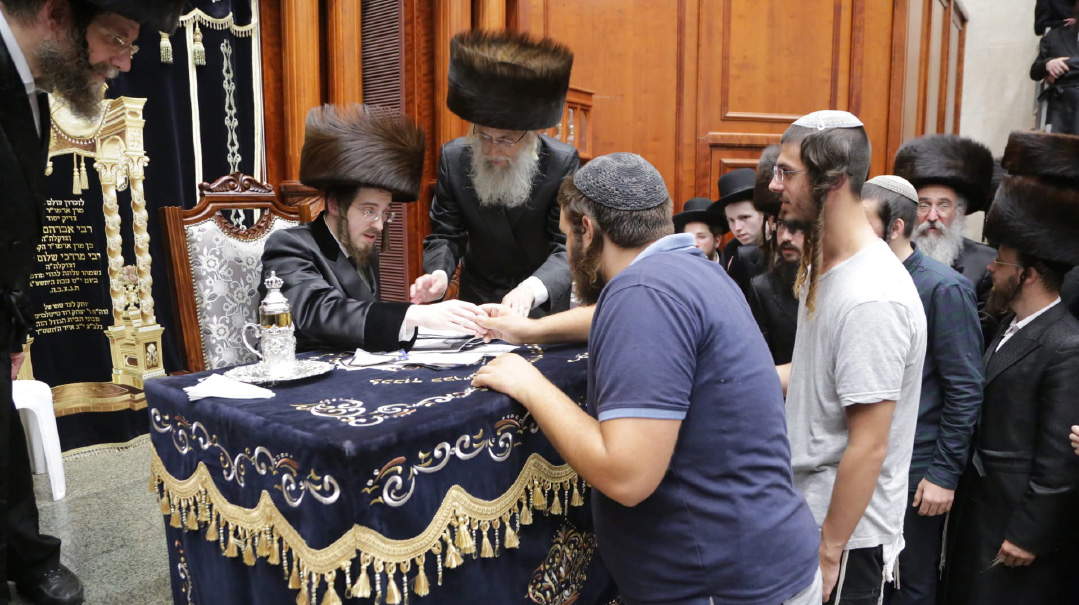
Dalia says she was happily surprised to find that the women of the Toldos Avraham Yitzchak kehillah, generally assumed to be more sheltered and insular than their husbands, were just as welcoming as the men.
“The warmth and acceptance, even though we look so obviously different, is one of the things that drew my husband here in the first place,” says Dalia, crowned with at least three kerchiefs that are piled high and intricately knotted above her head. “And the simchah. It’s true that these enclaves aren’t like Breslov or Chabad, which have their own seforim, hashkafot, and very specific hanhagot and direction for life. But the joy and the intense avodat Hashem – we didn’t really find that in the dati-leumi sector. My husband and his friends were looking for a framework with more vibrancy, more simchah, more striving for kedushah instead of just gliding through another day.”
Yair takes his little son to the Rebbe as well, and never misses a tish when he’s in Jerusalem, yet he has no plans to integrate into this kehillah he’s made his home — not when it comes to his children’s chinuch, and not in their manner of dress.
“We’re not really looking to become fully integrated into the chassidus,” says Dalia. “We know we’re different and are happy with who we are. We prefer to preserve our separate identity — we’re not getting swallowed up so fast.”
If people question how this fast-growing movement deals with the obvious disparity between their Zionist views and the anti-Zionist or neutral stance of the chassidic courts that are such a draw to them, the phenomenon is actually the backdrop to one of the best-kept secrets of an expanding swath of “srugim” society: that ideologically, some of them are not really so far away from their chassidic hosts after all.
There is an undercurrent within this sector that has begun to question classic Zionism. These people are searching for their own stance on the political entity of the post-Zionistic State of Israel, questioning whether the country has in fact twisted itself into irrevocable spiritual decline with its anti-Torah agendas, while forfeiting parts of the Holy Land to the enemy and harassing and persecuting those who continue to settle it.
Yair, for his part, is delaying army service for as long as he can as a yeshivah student (there are in fact thousands of bochurim in kippah serugah yeshivos who also defer their service) — both because he wants to learn as long as possible, and because he doesn’t believe in serving in a Jewish military that is not run on Torah principles.
Yair doesn’t say Hallel on Yom Ha’atzmaut, and, like the Eidah Hachareidis stalwarts, he doesn’t even vote.
Are his tish-going friends of the same mind? Although statistics are hard to prove, Yair believes that in the Torani-leumi world, it’s a movement that’s gaining traction.
“In the beginning,” he explains, “the secular state was necessary to set things up. It’s like the shell of a nut that protects and nurtures the meat until the nut matures, but once the nut matures, you have to get rid of the shell before it can actually cause damage to the nut it protected. It’s time for the old shell to be removed, and to create something new in the true spirit of Torah that will be eternal and enduring.”
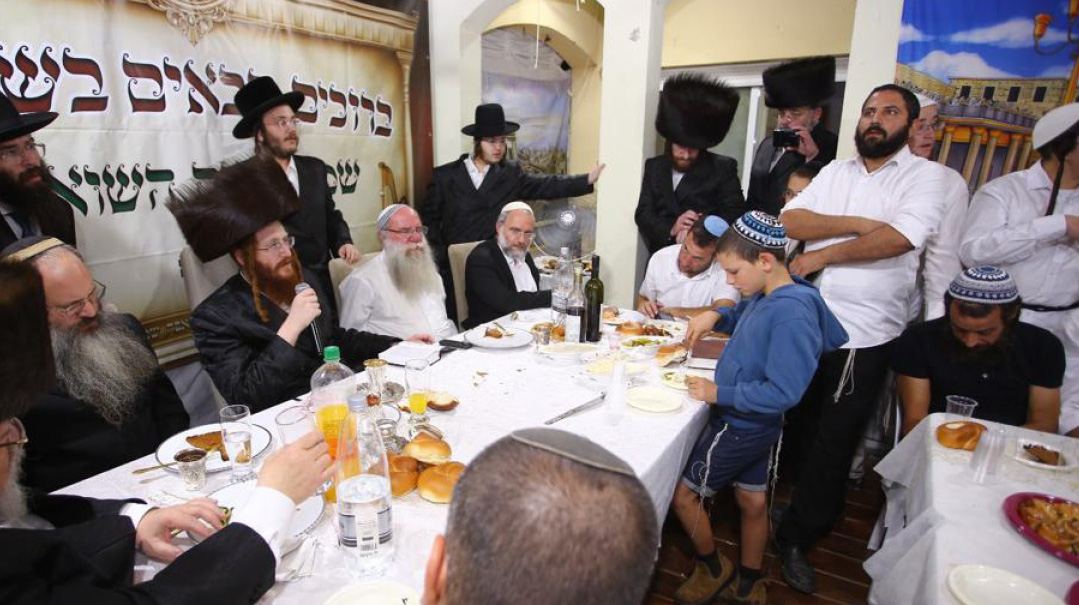
“When the previous Rebbe passed away, I thought, ‘Where do I go from here?’” The young Kaliver Rebbe with Rabbi Shneur Ketz and his talmidim at the very physical experience of a chassidish tish
Tied to the Rebbe
Down the block from Toldos Avraham Yitzchak, the Toldos Aharon chassidus is also a welcoming place for bochurim from the National Religious sector who attend the Rebbe’s Friday night tish on a regular basis.
“I recently finished four years of learning in Shalom Bonayich,” says 18-year-old Eli. “Around 25 of us would walk over to Toldos Aharon every Friday night, over an hour each way. We’re not becoming Rav Ahrelach, don’t worry, but there’s such an intense feeling of avodat Hashem there that feels like an electric current.”
In the past year, Reb Chaim Elazar Rosenfeld, a Toldos Aharon chassid who directs the Bayit Lepleitot institution near Meah Shearim, has taken charge of hosting the young bochurim from the srugim yeshivos. Eli is one of the regulars, and he’s glad. Last year, on Shevii shel Pesach, Eli and 20 friends slept on the floor in the cheder.
“The staff at Shalom Bonayich actually encourages us to develop our relationship with the chassidus,” Eli says, relating that the yeshivah has several staff members connected to various chassidic courts.
In Bnei Brak, the trend is similar. Students from the hesder yeshivah in Ramat Gan have been regulars at the Vizhnitzer court for years, where up to 2,000 chassidim and guests participate in the weekly Friday night tish.
Once of those young men is Adam Houri, who took his first steps in the chassidic world as a 14-year-old not long after he arrived at the yeshivah. “There were chevreh who went to tishen, and I decided to tag along,” he says. “It wasn’t long before I began to connect to the Rebbe — so energetic, joyful and sensitive, with lots of intensity. He lives the tzibbur. Soon I wasn’t only going to tishen, but also to the Rebbe’s grandchildren’s weddings, and also on private visits for brachos.”
Adam hasn’t yet become a chassid, but several of his friends have. One became a Vizhnitzer, another a Nadvorna chassid, and third became a Karliner.
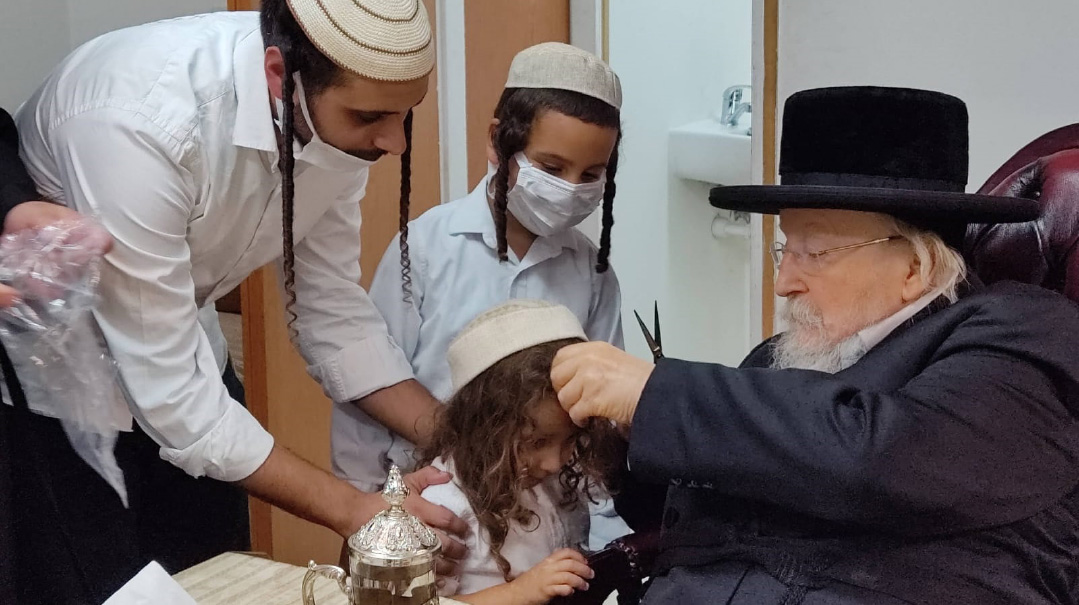
From the time the Biala Rebbe held his summer camp in the Golan, all types of chassidim have made their way to his court
Elkanah Klein, from the yishuv of Revavah in the Shomron, became close to the Kaliver chassidus in recent years. “My father would travel to Uman often and at some point, he began to wear a shtreimel. When my grandfather Rabbi Moshe Klein, rabbi of Hadassah Medical Center, heard about it, he commented, ‘My son is following the path of his great-grandfather, before he was murdered at Auschwitz.’ My father wanted to recapture the spiritual direction that had been lost to our family since the Holocaust.
Elkanah himself was drawn to the Kaliver Rebbe ztz”l, and after he passed away in 2019, Klein accepted the leadership of the new Rebbe unquestioningly, just like any other chassid. (The present Kaliver Rebbe, Rav Yisrael Mordechai Horowitz, is the grandson-in-law of the previous Rebbe. Although the Rebbe had no biological children, he and his rebbetzin adopted two young girls after the war. One of the girls married Rav Rafael Rosenberg, and Rav Horowitz, Rav Rosenberg’s son-in-law, was named the Rebbe’s successor in his will. He was just 28 at the time.)
“When the previous Rebbe passed away, I thought to myself, ‘Where do I go from here?’ But the new Rebbe was appointed, and true, it was a bit strange for me to go to such a young rebbe. A lot of people asked me, ‘What do you find in such a young rebbe?’ The answer is that if the previous Rebbe said something, we listened to him, and we listen to him even after his passing and continue to follow him. The current Rebbe was appointed by the previous Rebbe to continue his work locally and to travel around the world strengthening Jews in emunah. So who am I not to follow?”
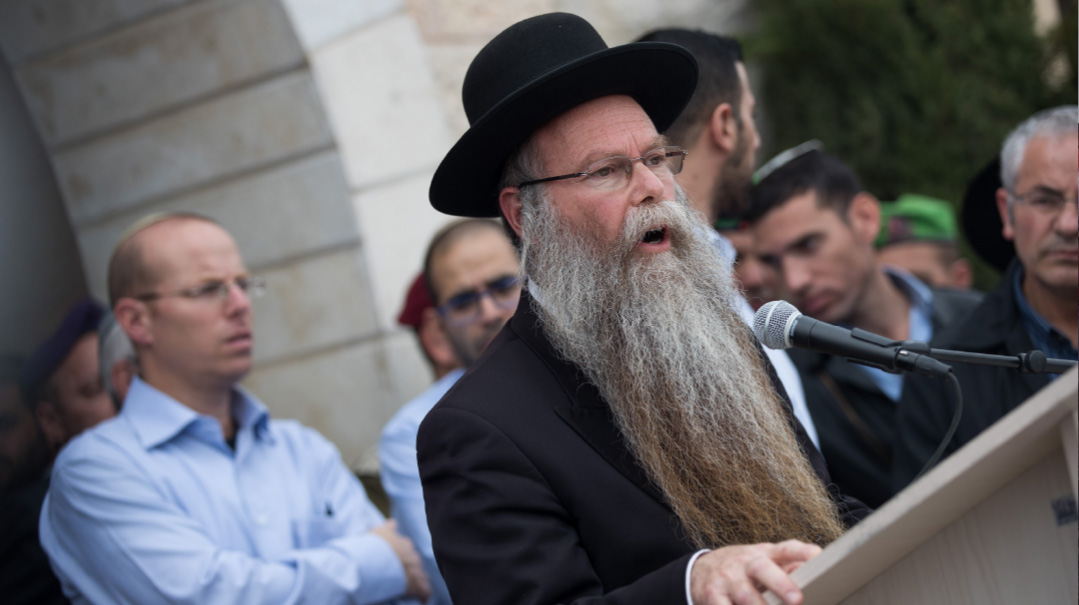
“I thank Hashem for these connections,” says Rabbi David Dudkevitch. “So many people today want to live a lifestyle that’s more holy”
Two-Way Street
In today’s national religious sector, you never know where you’ll find chassidim. Like Rabbi Harel Aryeh, a maggid shiur in a yeshivah in Beit El for bochurim growing stronger in their Judaism, who became a Biala chassid when he was just 13.
“Twenty-something years ago, the Biala chassidus used to hold their bochurim’s bein hazmanim getaway in Chispin,” says Rabbi Aryeh, whose father, Rabbi Netanel Aryeh, is a longtime maggid shiur in Yeshivat Hagolan. “I was near the yeshivah all the time, earning extra pocket money by cleaning and serving in the yeshivah’s kitchen, so in the summer, I’d seen the Biala Rebbe’s tish.” Yet he never imagined that one day, he’d become a close chassid.
Until his melamed in the Talmud Torah made a chanukas habayis during the time the Rebbe was in Chispin. The melamed asked the Rebbe to join, and from that point on, there was a special bond between the melamed and the Rebbe. When the melamed saw that young Harel was connecting to sifrei chassidus, he decided to take the young bochur with him to the Rebbe several times a year.
From there, the connection developed to become that of a rebbe and chassid. Soon Harel wouldn’t make a move without consulting the Biala Rebbe. “In every stage in life, the Rebbe was there with me, beginning with my choice of yeshivah high school and continuing throughout my life. I continue to have the Rebbe in my life every step of the way.
“The Rebbe is very practical,” he says, “yet at the same time ignites my chassidish neshamah and hislahavut in avodat Hashem. I’ve seen miracles, sometimes openly and sometimes more covertly. And I owe my success in chinuch to the Rebbe’s brachah and guidance. Eight years ago, when I started out as a maggid shiur, I was very anxious about being responsible for dozens of neshamot, but the Rebbe said to me: ‘If you think that you can take responsibility for one bochur, then go ahead with it, and b’ezras Hashem, you will see brachah in your work.’ His support continues to give me strength. I believe that everyone needs something in life that’s bigger and loftier to look up to.”
“So many people today want to live a lifestyle that is more holy — and not only in the beit medrash, not only in Torah learning. They want to know how a holy life looks, both on Yamim Tovim and on a daily basis,” says Rabbi David Dudkevich, rav of the yishuv Yitzhar and Rosh Yeshivat Ro’eh Yisrael. Today he’s a chassid in every way, from his peyos, long rekel and shtreimel to the chassidic farbrengens and tishen he holds in the yeshivah and his close connections to the Rebbes of Karlin, Slonim, and Beis Ruzhin.
Rabbi Dudkevitch, who grew up in Ramat Gan and went through the National Religious yeshivah and army track, became close with Rav Shlomo Zalman Auerbach ztz”l, while still a bochur in Yeshivat Kedumim and Ohr Etzion, which opened doors for him in the chareidi and chassidic worlds.
Rabbi Dudkevich sees great importance in this bridge, which he says keeps the entire community of yerei Hashem connected in a way that everyone can benefit and receive from one another. “I thank Hashem for these connections,” he says. “I don’t push my students into the chassidic world, but I open the doors for them, so that their hearts should be open to absorb things that they might be able to hear in other places.”
And from his experience, the positive energy of these new connections goes both ways. “The chassidim also enjoy these new friends — it helps them realign with a large sector of sincere Jews looking for more spirituality in their lives.”
(Originally featured in Mishpacha, Issue 963)
Oops! We could not locate your form.







